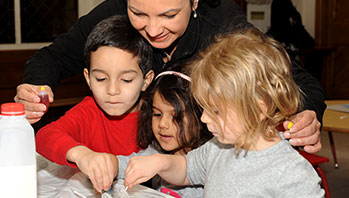- paper
- markers
- building materials (e.g., sticks, straw, plastic, big flat rocks, bricks, wood, blocks, pieces of concrete, etc.)
MA Standards:
Writing: W.PK.MA.2 Use a combination of dictating and drawing to explain information about a topic.
MA Draft STE Standards:
Physical Sciences/Matter and Its Interactions/PS1.A Describe, compare, sort and classify objects based on observable physical characteristics, uses, and whether it is manufactured as part of their classroom play and investigations of the natural and human-made world.
Head Start Outcomes:
Literacy Knowledge/Early Writing Uses scribbles, shapes, pictures, and letters to represent objects, stories, experiences, or ideas.
PreK Learning Guidelines:
English Language Arts/Composition 16 Use their own words or illustrations to describe their experiences, tell imaginative stories, or communicate information about a topic of interest.
Small Group: Different Materials

© Commonwealth of Massachusetts, Department of Early Education and Care (Jennifer Waddell photographer). All rights reserved.
STEM Key Concepts: Different materials are useful for making different structures and different parts of structures
ELA Focus Skills: Listening and Speaking, Vocabulary, Early Writing
Educator Prep: Assemble a journal for each child by folding a few sheets of paper in half and stapling them together on the crease line. Write "Building Materials" on the cover sheet and add a name line for each child to write his or her name.
Distribute children’s journals. Read the title and have children write their name on the cover. Then display and introduce the building materials to children. Encourage children to use the materials to build. Invite children to record their observations and ideas about which materials are best to use for their purposes and why. Prompt them by asking questions such as,
- How did you build the door to your house? Which materials did you use? Why?
- Draw your door to the house. What shape is it? Why is that the best shape for a door?
Allow children time to share their recordings and ideas about the materials.
